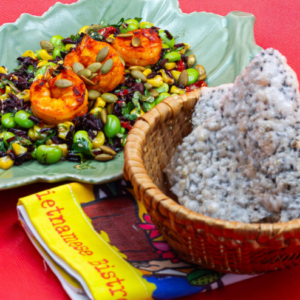Chả giò, or fried spring rolls, is a beloved dish in Vietnamese cuisine, celebrated for its crispy exterior and flavorful filling. This culinary delight holds a special place in the hearts of Vietnamese people, often gracing festive occasions, family gatherings, and everyday meals.
A Symphony of Flavors
The allure of chả giò lies in its harmonious blend of textures and tastes. The outer layer, a delicate rice paper wrapper, is transformed into a golden-brown, crispy shell through deep-frying. Inside, a medley of ingredients awaits: ground pork or shrimp, vermicelli noodles, wood ear mushrooms, carrots, and a medley of aromatic herbs and spices. This flavorful filling is carefully wrapped within the rice paper, creating a cylindrical parcel that is both visually appealing and incredibly satisfying.
A Cultural Tapestry
Chả giò’s roots trace back to the ancient kingdom of Champa, a Southeast Asian civilization that once thrived in central Vietnam. The Champa people were skilled artisans and culinary innovators, and their influence can be seen in various aspects of Vietnamese cuisine, including chả giò. Over time, the dish evolved, incorporating Chinese and French culinary influences, resulting in the diverse and delicious chả giò we know today.
A Versatile Culinary Creation
Chả giò is remarkably versatile, adapting to regional preferences and culinary traditions. In northern Vietnam, chả giò often features a filling of ground pork, vermicelli noodles, and wood ear mushrooms. In central Vietnam, the filling may include shrimp, pork, and a variety of vegetables. Southern Vietnam, known for its bold and flavorful cuisine, often incorporates a blend of pork, shrimp, and crab meat into the chả giò filling.
A Culinary Celebration
Chả giò is an integral part of Vietnamese celebrations, from Lunar New Year to weddings and birthdays. It is often served as an appetizer or as part of a larger meal, accompanied by a variety of dipping sauces. The most popular dipping sauce is a sweet and sour mixture made with fish sauce, sugar, lime juice, and chili peppers. This tangy and spicy sauce perfectly complements the rich and savory flavors of the chả giò.
A Global Culinary Sensation
In recent years, chả giò has gained international recognition, captivating the palates of food enthusiasts around the world. Its unique combination of flavors, textures, and cultural significance has made it a popular dish in Vietnamese restaurants and fusion cuisine establishments.
A Recipe for Tradition
While chả giò can be enjoyed at restaurants, many Vietnamese families continue to prepare this dish at home, passing down the recipe from generation to generation. Making chả giò is a labor-intensive process, but the reward is a delicious and satisfying meal that brings family and friends together.
Ingredients:
- Rice paper wrappers
- Ground pork or shrimp
- Vermicelli noodles
- Wood ear mushrooms
- Carrots
- Green onions
- Garlic
- Ginger
- Fish sauce
- Sugar
- Black pepper
- Vegetable oil for frying
Instructions:
- Prepare the filling:
- Soak the vermicelli noodles in warm water until softened. Drain and set aside.
- Mince the garlic, ginger, and green onions.
- In a large bowl, combine the ground pork or shrimp, vermicelli noodles, wood ear mushrooms, carrots, minced garlic, ginger, and green onions.
- Season with fish sauce, sugar, and black pepper. Mix well.
- Assemble the spring rolls:
- Place a rice paper wrapper on a damp surface.
- Spoon a portion of the filling onto the center of the wrapper.
- Fold the sides of the wrapper over the filling, then roll it up tightly.
- Repeat with the remaining filling and wrappers.
- Fry the spring rolls:
- Heat vegetable oil in a deep fryer or large pot to 350°F (175°C).
- Carefully add the spring rolls to the hot oil, a few at a time.
- Fry until golden brown and crispy, turning occasionally.
- Remove the spring rolls from the oil and drain on paper towels.
- Serve:
- Serve the chả giò hot with a dipping sauce of your choice.
A Culinary Legacy
Chả giò is more than just a delicious dish; it is a symbol of Vietnamese culture and heritage. Its enduring popularity is a testament to its ability to bring people together, evoke nostalgia, and celebrate the richness of Vietnamese culinary traditions. As we savor each bite of this crispy and flavorful delight, we are not only enjoying a culinary masterpiece but also participating in a time-honored tradition that continues to captivate the world.




